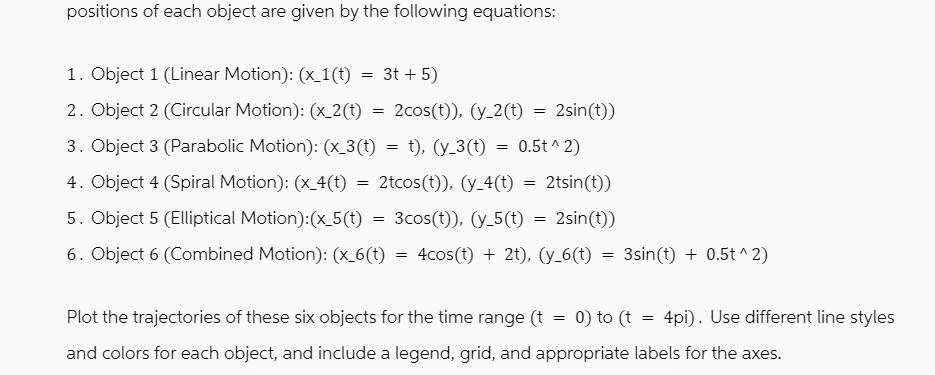Answered step by step
Verified Expert Solution
Question
1 Approved Answer
positions of each object are given by the following equations: 1. Object 1 (Linear Motion): (x_1(t) = 3t+5) 2. Object 2 (Circular Motion): (x_2


positions of each object are given by the following equations: 1. Object 1 (Linear Motion): (x_1(t) = 3t+5) 2. Object 2 (Circular Motion): (x_2 (t) 2cos(t)), (y_2(t) = 2sin(t)) 3. Object 3 (Parabolic Motion): (x_3(t) = t), (y_3(t) = 0.5t^2) 4. Object 4 (Spiral Motion): (x_4(t) = 2tcos(t)), (y_4(t) = 2tsin(t)) 5. Object 5 (Elliptical Motion): (x_5(t) = 3cos(t)), (y_5(t) = 2sin(t)) 6. Object 6 (Combined Motion): (x_6(t) = 4cos(t) + 2t), (y_6(t) = 3sin(t) + 0.5t^2) = = 0) to (t Plot the trajectories of these six objects for the time range (t 4pi). Use different line styles and colors for each object, and include a legend, grid, and appropriate labels for the axes. = Y-axis 80 60 40 20 -20 -40 -200 200 Motion of Six Objects 400 X-axis 600 Object 1 (Linear Motion) Object 2 (Circular Motion) -Object 3 (Parabolic Motion) Object 4 (Spiral Motion) Object 5 (Elliptical Motion) Object 6 (Combined Motion) 800 1000
Step by Step Solution
There are 3 Steps involved in it
Step: 1

Get Instant Access to Expert-Tailored Solutions
See step-by-step solutions with expert insights and AI powered tools for academic success
Step: 2

Step: 3

Ace Your Homework with AI
Get the answers you need in no time with our AI-driven, step-by-step assistance
Get Started


